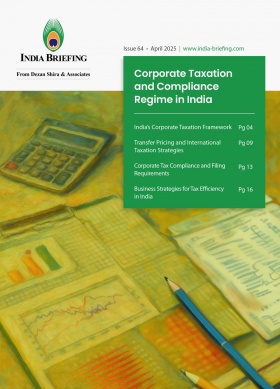TDS Rules for Payments to NRIs and Foreign Companies in India: An Explainer
India’s Income Tax Act 1961, Section 195, mandates tax deduction at source (TDS) on payments to non-resident Indians (NRI), making it a critical compliance requirement for businesses engaged in cross-border transactions involving royalties, interest, or technical service fees.
Indian entities often pay royalties for intellectual property (IP), interest on overseas borrowings, or fees for technical services provided by foreign companies. Likewise, non-resident individuals and foreign corporations regularly earn income from Indian sources.
To ensure that such income does not escape taxation, Section 195 of the Income Tax Act, 1961, mandates that tax be deducted at source (TDS) from payments made to non-residents and foreign entities when the sum is chargeable to tax in India. For businesses and investors, understanding this provision is critical to maintaining compliance, avoiding penalties, and optimizing cash flows.
ALSO READ: India’s New Income Tax Act, 2025 Notified: Key Changes and Implementation Timeline
Understanding TDS rules under the Section 195 framework
Section 195 applies to any person, including individuals, Hindu Undivided Families (HUFs), partnership firms, limited liability partnerships (LLPs), Indian and foreign companies, government bodies, banks, and other juridical persons, who is responsible for paying any sum (other than salary) that is chargeable under the Act to a non-resident.
The provision’s scope covers payments such as interest, dividends, royalties, fees for technical services, and even capital gains. The key condition is that the income must be chargeable to tax in India under the provisions of the Act. Even if the payer has no taxable presence in India, the obligation to deduct TDS may still arise.
Who counts as a non-resident Indian?
The residential status of an individual is determined under Section 6 of the Income Tax Act, 1961. Generally, an individual is a non-resident if they do not meet either of the prescribed stay-duration conditions:
- Staying in India for 182 days or more during the financial year; or
- Staying for 60 days or more during the financial year and 365 days or more in the four preceding financial years.
For Indian citizens or Persons of Indian Origin (PIOs), defined as individuals who were born in, or whose parents or grandparents were born in, undivided India, special provisions apply. If their total Indian income (excluding income from foreign sources) exceeds INR 1.5 million (US$17,113) in a financial year, the 60-day limit becomes 120 days. For Indian citizens leaving India for employment abroad or serving as crew on an Indian ship, the 182-day threshold continues to apply.
READ MORE: Avoid Excess Tax Deductions in India: NRI Guide to Lower TDS Certificates
When TDS must be deducted
Payers must deduct TDS under Section 195 either when they credit the sum to the payee’s account or when they make the payment, whichever happens first. Credit also covers amounts entered in a suspense account or any other account where the liability is acknowledged.
If the payment is taxable in India, payers must deduct TDS without any threshold exemption, regardless of the amount. The section does not apply only when the income is wholly exempt under the Act or covered by a specific notification.
Where a Double Taxation Avoidance Agreement (DTAA) exists, the payer may apply the lower rate prescribed in the treaty, provided the non-resident furnishes a valid Tax Residency Certificate (TRC) and other required details such as Form 10F.
Royalties, interest, and fees for technical services
While Section 195 applies to many income categories, payments for royalties, interest, and fees for technical services are among the most common in business transactions.
- Royalties include payments for the use of patents, trademarks, designs, copyrights, software licenses, or similar intellectual property.
- Interest covers payments on loans, debt instruments, and certain bank accounts.
- Fees for technical services refer to managerial, technical, or consultancy services, whether rendered in India or abroad.
For example, an Indian company paying a software license fee to a US vendor, interest on a foreign currency loan to a Japanese bank, or consulting fees to a UK engineering firm will generally need to deduct TDS under Section 195, unless a DTAA provides relief.
Procedure and compliance requirements
Once TDS is deducted, the tax must be deposited with the central government within the prescribed time limits, generally by the seventh day of the following month, and by April 30 for deductions made in March. Payment is made using Challan ITNS-281 through authorized banks or an e-payment.
The payer must file a quarterly TDS return through Form 27Q, which reports all payments to non-residents and the TDS deducted. The due dates are:
- July 31 for April–June
- October 31 for July–September
- January 31 for October–December
- May 31 for January–March
For remittances abroad, the payer must also furnish Form 15CA to the income tax department before remittance. In certain cases, obtain a chartered accountant’s certificate through Form 15CB certifying the nature and taxability of the payment.
TDS certificates and lower deduction applications
The deductor must issue a TDS certificate through Form 16A to the non-resident payee within 15 days of the due date for furnishing the TDS statement for the relevant quarter. This certificate serves as proof that tax has been deducted and deposited.
If the non-resident believes their actual tax liability in India is lower than the standard rate, they can apply to the assessing officer under Section 197 for a certificate of nil TDS deduction by submitting Form 13. This avoids excess withholding and the need to later claim a refund.
Rates of TDS under Section 195
When making a payment to a non-resident or foreign entity that is chargeable to tax, the applicable TDS rate will be the one that is more beneficial to the recipient. This means the rate will be the lower of:
- The rate provided in the Finance Act for that financial year, plus applicable surcharge and health and education cess at 4 percent; or
- The rate specified in the relevant DTAA between India and the payee’s country of residence. If the DTAA rate is applied, no surcharge or cess is added to that rate.
The key rates under the Finance Act 2025, before adding surcharge and cess, are outlined in the table below.
|
Category |
Applicable rate |
Relevant section |
|
Long-term capital gains (shares of an Indian company, specified debentures or deposits, certain government securities) |
10 percent |
Section 115E |
|
Long-term capital gains on listed shares or securities |
12.5 percent (for transfers made on or after 23 July 2024); 10 percent (for transfers made before 23 July 2024) |
Section 112A |
|
Other long-term capital gains |
20 percent |
Section 112 |
|
Short-term capital gains from securities held by FIIs or specified funds (other than units of UTI or mutual funds) |
20 percent |
Section 115AD |
|
Short-term capital gains |
15 percent |
Section 111A |
|
Interest payable by the Government or an Indian entity on money borrowed in foreign currency |
20 percent |
Section 115A(1)(a)(i) |
|
Royalty and fees for technical services payable by the Government or an Indian entity |
10–20 percent |
Section 115A(1)(b) |
If the payee does not furnish a Permanent Account Number (PAN), Section 206AA mandates deduction at the higher of the applicable rate or 20 percent.
READ MORE: Guide to India’s TDS Rates for FY 2025-26
A compliance checklist for Section 195
- Obtain a Tax Deduction Account Number (TAN) as required under Section 203A.
- Collect the PAN of both the payer and the non-resident payee. The PAN of the NRI seller should submit Form 49B.
- Deduct TDS at the correct rate, either as per the Finance Act or the DTAA, whichever is more beneficial to the payee.
- Deposit the deducted tax by the seventh of the following month, using Challan ITNS-281 through an authorized bank or the e-payment portal.
- File the quarterly TDS return through Form 27Q, reporting all payments to non-residents and the tax deducted.
- Issue Form 16A (TDS certificate) to the payee within 15 days of the due date of the TDS return for that quarter.
- For remittances outside India:
1. Submit Form 15CA, a self-declaration by the remitter, online to the income tax department.
2. Obtain Form 15CB from a chartered accountant, if required, certifying the nature and taxability of the payment.
Non-compliance with Section 195 can trigger multiple tax and penalty implications under the Act.
Disallowance of expenditure – Section 40(a)(i)
If TDS is not deducted on a payment that is taxable in India, or if it is deducted but not deposited with the government on or before the due date for filing the income tax return, the expenditure may be disallowed. For payments to non-residents under Section 40(a)(i), the full amount can be disallowed; for payments to residents under Section 40(a)(ia), 30 percent of the amount will be disallowed. The deduction can be restored in the year the tax is eventually deducted and deposited.
Interest for delay – Section 201(1A)
If there is a delay in deduction of TDS, interest is charged at 1 percent per month or part thereof from the date it was deductible until the date it is deducted. If TDS is deducted but paid late, interest at 1.5 percent per month or part thereof is payable from the date of deduction to the date of payment to the government. The calculation is done on a full-month basis, and interest under this section is not an allowable business deduction.
Penalty for failure to deduct or pay
Under Section 271C, where a person fails to deduct all or part of the tax as required, or, after deducting, fails to pay it to the government, a penalty equal to the amount of tax that was not deducted or not paid may be imposed. This penalty is in addition to the liability to pay the tax and interest.
Penalty for non-filing or incorrect filing of Form 15CA/15CB
Under Section 271I, failure to furnish Form 15CA or 15CB, or furnishing inaccurate information in contravention of Section 195(6), attracts a penalty of INR 100,000 (US$1,142) per instance. Since the 2015 amendment of the Finance Act, Form 15CA is generally required for most foreign remittances, whether or not they are chargeable to tax, unless exempted under Rule 37BB. The assessing officer may waive this penalty under Section 273B if the taxpayer demonstrates a reasonable cause for non-compliance
(US$1 = INR 87.49)
About Us
India Briefing is one of five regional publications under the Asia Briefing brand. It is supported by Dezan Shira & Associates, a pan-Asia, multi-disciplinary professional services firm that assists foreign investors throughout Asia, including through offices in Delhi, Mumbai, and Bengaluru in India. Dezan Shira & Associates also maintains offices or has alliance partners assisting foreign investors in China, Hong Kong SAR, Vietnam, Indonesia, Singapore, Malaysia, Mongolia, Dubai (UAE), Japan, South Korea, Nepal, The Philippines, Sri Lanka, Thailand, Italy, Germany, Bangladesh, Australia, United States, and United Kingdom and Ireland.
For a complimentary subscription to India Briefing’s content products, please click here. For support with establishing a business in India or for assistance in analyzing and entering markets, please contact the firm at india@dezshira.com or visit our website at www.dezshira.com.
- Previous Article India’s Passport Rules 2025: Key Changes You Need to Know
- Next Article Processing Payroll for Expats and Locals in India: Key Differences








